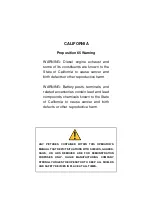
31
Clutch will slip or disengage incompletely in operating because of parts wearing, so it must
be adjusted in time to ensure the tractor’s normal working status.
The structure of the linkage-type, double acting clutch is shown as Fig. 4. It mainly consists
of three parts: the driving part, driven part and controlling part. The driving part rotates
with the engine flywheel; only when the clutch engages can the driven part rotate with the
engine.
Double acting clutch should be adjusted on the flywheel. The adjusting steps are as follows:
a.
Loosen the nut M10
×
1 (18), adjust the length of adjusting bolt (20) to make the
distance between three release levers (17) and the end face of flywheel be of L = 156.5
mm. Meanwhile, the tips of three release levers should be kept in the same vertical
plane with a permissible error range of 0 to 0.20 mm. After adjustment is done, tighten
the nut M10
×
1 (18).
b. Loosen the nut M10
×
1 (7), adjust the length of Adjusting bolt (8) to make the distance
between the end faces of Adjusting bolt (8) and the Sub-clutch pressure plate be of
0.9
~
1 mm. After adjustment is done, tighten the nut M10
×
1 (7)
c. Loosen the nut M10
×
1 , adjust the length of pull rod (11) until the free travel of pedal
reaches 30
±
2 mm, ensure that the clearance from tips of three release levers (17) and
the release bearing assembly (16) is of 2
~
2.5 mm, then tighten the nut M10
×
1 .
After adjustment is done, step on the clutch pedal, the main clutch and sub-clutch
should be disengaged in turn; after releasing the pedal, the main clutch and sub-clutch
should be engaged smoothly and work reliably.
Fig. 4 Linkage-type double-acting clutch
1. Main clutch driven disk assembly 2. Main clutch pressure plate 3. Dish spring
4. Fixed clutch pressure plate 5. Sub-clutch driven disc 6. Sub-clutch pressure plate
7. Nut M10×1 8. Adjusting bolt 9. Clutch cover 10. Ruturn spring 11. Pull rod
12.
Clutch pedal 13.Release shaft 14
Release bearing seat 15
Release fork.











































